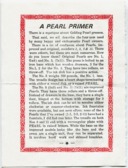The Golding Pearl is a line of relatively small but still floor-standing platen printing presses last manufactured in 1927 which has enjoyed an excellent reputation from the 19th through the 21st centuries.
I am still slightly baffled by the evolution of the Pearl. Here's what I think I know - but please don't cite this as correct, because I'm just collating sometimes conflicting sources.
The very first "Pearl" press by Golding, in about 1872, was a hand-operated tabletop press. Saxe discusses it, and reproduces a photograph of its patent model, in his APHA paper (see below). Elizabeth M. Harris, in Personal Impressions: The Small Printing Press in Nineteenth-Century America (Boston and London: David R. Godine and The Merrion Press, 2004) lists this first Pearl (or a development of it?) as a self-inking press in a 6x9 inch size in production from 1872 to 1877 (p. 109-110).
Harris lists the first Pearls of the style now familiar, variously equipped with hand levers, foot levers, treadles, or steam attachments, and variously in hand-inking or self-inking versions, as dating from about 1875 (p. 110). She lists these as:
Harris then lists three models of "improved" Pearl dating from "after 1876" - but these are not the "Improved Pearl" as later known, because they did not, apparently, have throw-off levers. Their model numbering conflicts with the earlier versions, and their chase sizes differ. Saxe (APHA article, p. 16) suggests that treadle-operated Pearls were shown at the 1876 Centennial Exposition in Philadelphia. Harris lists:
The late Harold E. Sterne, in his book A Catalogue of Nineteenth Century Printing Presses (New Castle, DE: Oak Knoll Press & The British Library, 2001) reproduces a Golding & Co. advertisement from about 1880 which lists a line of Pearls as follows:
One presumes that the Nos. 1 and 3 in this circa 1880 advertisement did not have a throw-off. Saxe confirms this, saying that "only the large, 9x14 old-style Pearl was made with a throwoff" (p. 19). (One Pearl No. 1 exists today with a throw-off, but it was remanufactured and this is a later addition.)
Harris (p. 111) lists this same line-up (1, 3, 5) as dating from 1895 and all as "Improved Pearls" having throw-offs. I'm guessing that this must be an error, however, as she cites as her source Sterne's book and its 1880 Golding advertisement. Harris lists no Pearls with model numbers higher than 5.
Saxe dates the introduction of the Improved Pearl to 1895.
The 1898 to 1911 Golding & Co. engineering drawing "Form Roller Wheels" (preserved by Stephen O. Saxe) lists roller and core data for the Pearls Nos. 1, 3, 5, 11, 14, and (out of sequence) 8. It also gives dimensioned drawings of Form Roller Wheels (that is, trucks) for each of these. The undated Golding table "Cast Roller & Roller Core Data" (also preserved by Stephen O. Saxe) lists all of these models except the No. 5.
Just to confuse matters further, Sterne reproduces cuts of the No. 14 both with and without throwoff (p. 142). He dates these to 1896.
The 1908 Golding catalog reformatted and reprinted by Dave Tribby for the AAPA (see below) lists the following Pearls in production:
The undated booklet "The Pearl Press" online in PDF format on John Falstrom's site and formerly online on Stephen Nelson's handpress.org site (for both, see below) lists this same line-up.
Some confusion attends the habit of referring to Pearls as "old style" and "new style." Golding sales literature such as The Pearl Press (see below) refers to the Nos. 1 and 3 as either just the "Pearl" or the "Original Pearl" and to the Nos. 8, 11, and 14 as the "Improved Pearl." In itself this is clear enough. It is perhaps natural, as well, to call the original Pearl the "old style" and the Improved Pearl the "new style," and this is often done. By itself that is clear enough, as well.
But an examination of the 1898-1911 Golding engineering drawing "Form Roller Wheels," which shows the trucks for most Golding presses, reveals that Golding used the abbreviations "O.S." and "N.S." not to distinguish the original from the Improved Pearls, but rather to distinguish two different, incompatible, generations of roller/core/truck mechanisms for three specific presses: the Improved Pearl No. 8, the Improved Pearl No. 11, and the Jobber No. 18.

Tribby. "Golding Printing Presses"
The best quick introduction to Golding presses is Dave Tribby's web page, "Golding Printing Presses" on the American Amateur Press Association website at http://www.aapainfo.org/golding/ In it he reprints a reformatted version of a 1908 Golding catalog which has useful information discussing the technical features of the press. He also reproduces several Golding parts diagrams, courtesy of Steve Saxe.

Saxe. "A Brief History of Golding & Co."
The best history of the Golding company is Stephen O. Saxe's "A Brief History of Golding & Co." in Printing History, Vol. 3, No. 2, Whole No. 6 (1981): 13-19, Saxe's article is online at the American Printing History Association's website, at: http://www.printinghistory.org/publications/printing-history/os-contents.php

Falstrom. 1900 Golding Catalog Reprint
John Falstrom (Perennial Designs) has reprinted (in paper, for sale) a 1900 Golding catalog, and typically has both restored presses and reproduction parts for sale on his website: http://www.perennialdesigns.net/
He also has online a number of useful Golding documents (see his page at http://www.perennialdesigns.net/?page_id=414 ). For the Pearl, these include: a Golding booklet The Pearl Press [the same scan was formerly available on handpress.org; see below], a "Diagram of Component Parts" for the Pearls Nos. 1 and 3, and a "Diagram of Component Parts for the Improved Pearls Nos. 8 and 11.

The Pearl Press
The Pearl Press. (Franklin, MA: Golding Mfg. Co., n.d.) It illustrates the (Original) Pearl No. 3 (7x11 in.), Improved Pearl No. 8 (5x8 in.), Improved Pearl No. 11 (7x11 in.); it lists for sale the Original Nos. 1 & 3 and the Improved Nos. 8, 11, and 14.
Stephen Nelson and Handpress.org: http://www.handpress.org has put this online at http://www.handpress.org/Reference/PDFcollection/PDFs/platen_jobber/golding_pearl_1.pdf.
[Note: On 2009-10-24 this site failed to come up. The Internet Archive ( http://www.archive.org lists it as having zero pages in 2009. These pages are still (at this time) available through The Internet Archive. Go to http://www.archive.org and plug "www.handpress.org" into "The Wayback Machine."]
This same scan is presently available on John Falstrom's "Perennial Designs" website (see above), on his page at: http://www.perennialdesigns.net/?page_id=414.

A Pearl Primer
Scott, Duane. "A Pearl Primer." (Eveleth, MN: The Scott Free Press, n.d.) Reprinted by permission.
Note: Duane Scott is no longer at the address printed on this piece. Neither are the telephone number or e-mail address current.

Making Form Roller Wheels (Trucks)
Making modern Form Roller Wheels (which is what Golding called them, or "trucks" in contemporary terminology) in Delrin® for the Pearl No. 1 and No. 11, together with a study of the surviving data.
"A Pearl Primer" by Duane Scott is copyright by Duane Scott. It is reprinted here with the kind permission of his daughter, Rachel Scott. Please do not republish it further without the permission of Rachel or Duane Scott.
All portions of this document not noted otherwise are Copyright © 2011-2012 by David M. MacMillan and Rollande Krandall.
Circuitous Root is a Registered Trademark of David M. MacMillan and Rollande Krandall.
This work is licensed under the Creative Commons "Attribution - ShareAlike" license. See http://creativecommons.org/licenses/by-sa/3.0/ for its terms.
Presented originally by Circuitous Root®
Select Resolution: 0 [other resolutions temporarily disabled due to lack of disk space]